Android 14 incluye excelentes funciones y APIs para desarrolladores. A continuación, se incluyen secciones que te ayudarán a obtener información sobre las funciones de tus apps y a comenzar a usar las APIs relacionadas.
Para obtener una lista detallada de las APIs agregadas, modificadas y quitadas, consulta el informe de diferencias de la API. Para obtener detalles sobre las APIs agregadas, consulta la referencia de la API de Android. En Android 14, busca las APIs que se agregaron en el nivel de API 34. Para obtener información sobre las áreas en las que los cambios de la plataforma podrían afectar tus apps, asegúrate de revisar los cambios en el comportamiento de Android 14 para apps orientadas a Android 14 y para todas las apps.
Internacionalización
Preferencias de idioma de las apps
Android 14 expands on the per-app language features that were introduced in Android 13 (API level 33) with these additional capabilities:
Automatically generate an app's
localeConfig: Starting with Android Studio Giraffe Canary 7 and AGP 8.1.0-alpha07, you can configure your app to support per-app language preferences automatically. Based on your project resources, the Android Gradle plugin generates theLocaleConfigfile and adds a reference to it in the final manifest file, so you no longer have to create or update the file manually. AGP uses the resources in theresfolders of your app modules and any library module dependencies to determine the locales to include in theLocaleConfigfile.Dynamic updates for an app's
localeConfig: Use thesetOverrideLocaleConfig()andgetOverrideLocaleConfig()methods inLocaleManagerto dynamically update your app's list of supported languages in the device's system settings. Use this flexibility to customize the list of supported languages per region, run A/B experiments, or provide an updated list of locales if your app utilizes server-side pushes for localization.App language visibility for input method editors (IMEs): IMEs can utilize the
getApplicationLocales()method to check the language of the current app and match the IME language to that language.
API de Grammatical Inflection
3 billion people speak gendered languages: languages where grammatical categories—such as nouns, verbs, adjectives, and prepositions—inflect according to the gender of people and objects you talk to or about. Traditionally, many gendered languages use masculine grammatical gender as the default or generic gender.
Addressing users in the wrong grammatical gender, such as addressing women in masculine grammatical gender, can negatively impact their performance and attitude. In contrast, a UI with language that correctly reflects the user's grammatical gender can improve user engagement and provide a more personalized and natural-sounding user experience.
To help you build a user-centric UI for gendered languages, Android 14 introduces the Grammatical Inflection API, which lets you add support for grammatical gender without refactoring your app.
Preferencias regionales
Las preferencias regionales permiten que los usuarios personalicen las unidades de temperatura, el primer día de la semana y los sistemas de numeración. Una persona europea que vive en los Estados Unidos podría preferir que las unidades de temperatura estén en Celsius en lugar de Fahrenheit y que las apps consideren el lunes como comienzo de la semana en lugar de los domingos, la opción predeterminada en EE.UU.
Los nuevos menús de configuración de Android para estas preferencias les proporcionan a los usuarios una ubicación detectable y centralizada para cambiar las preferencias de las apps. Estas preferencias también se mantienen en copias de seguridad y restablecimientos. Varias APIs y algunos intents, como getTemperatureUnit y getFirstDayOfWeek, le otorgan a tu app acceso de lectura a las preferencias de los usuarios, por lo que tu app puede ajustar la forma en que muestra la información. También puedes registrar un BroadcastReceiver en ACTION_LOCALE_CHANGED para controlar los cambios de configuración regional cuando cambien las preferencias regionales.
Para encontrar esta configuración, abre la app de Configuración y dirígete a Sistema > Idiomas y entrada > Preferencias regionales.


Accesibilidad
Escalamiento de fuente no lineal al 200%
Starting in Android 14, the system supports font scaling up to 200%, providing users with additional accessibility options.
To prevent large text elements on screen from scaling too large, the system applies a nonlinear scaling curve. This scaling strategy means that large text doesn't scale at the same rate as smaller text. Nonlinear font scaling helps preserve the proportional hierarchy between elements of different sizes while mitigating issues with linear text scaling at high degrees (such as text being cut off or text that becomes harder to read due to an extremely large display sizes).
Test your app with nonlinear font scaling
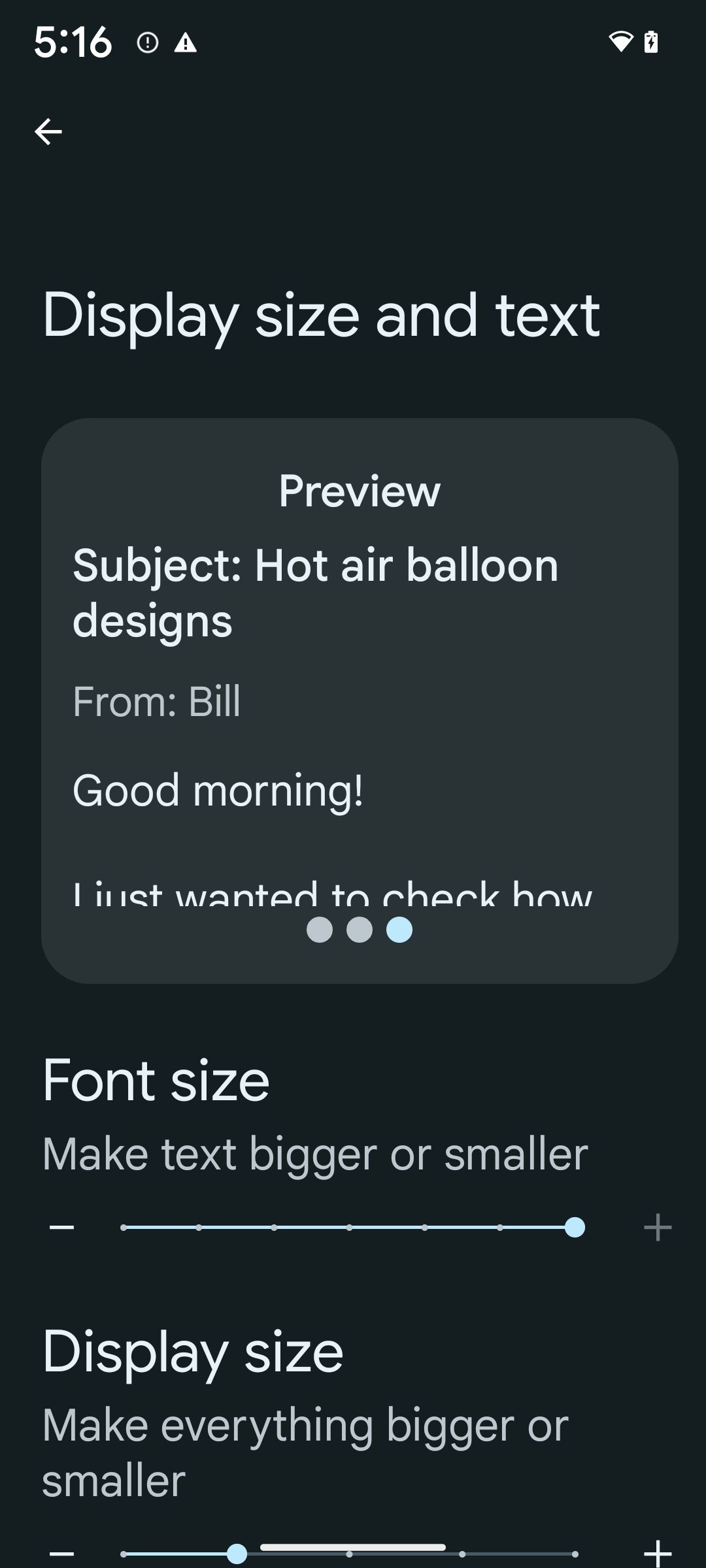
If you already use scaled pixels (sp) units to define text sizing, then these additional options and scaling improvements are applied automatically to the text in your app. However, you should still perform UI testing with the maximum font size enabled (200%) to ensure that your app applies the font sizes correctly and can accommodate larger font sizes without impacting usability.
To enable 200% font size, follow these steps:
- Open the Settings app and navigate to Accessibility > Display size and text.
- For the Font size option, tap the plus (+) icon until the maximum font size setting is enabled, as shown in the image that accompanies this section.
Use scaled pixel (sp) units for text-sizes
Remember to always specify text sizes in sp units. When your app uses sp units, Android can apply the user's preferred text size and scale it appropriately.
Don't use sp units for padding or define view heights assuming implicit padding: with nonlinear font scaling sp dimensions might not be proportional, so 4sp + 20sp might not equal 24sp.
Convert scaled pixel (sp) units
Use TypedValue.applyDimension() to convert from sp units
to pixels, and use TypedValue.deriveDimension() to
convert pixels to sp. These methods apply the appropriate nonlinear scaling
curve automatically.
Avoid hardcoding equations using
Configuration.fontScale or
DisplayMetrics.scaledDensity. Because font scaling is
nonlinear, the scaledDensity field is no longer accurate. The fontScale
field should be used for informational purposes only because fonts are no longer
scaled with a single scalar value.
Use sp units for lineHeight
Always define android:lineHeight using sp units instead
of dp, so the line height scales along with your text. Otherwise, if your text
is sp but your lineHeight is in dp or px, it doesn't scale and looks cramped.
TextView automatically corrects the lineHeight so that your intended
proportions are preserved, but only if both textSize and lineHeight are
defined in sp units.
Cámara y contenido multimedia
Ultra HDR para imágenes
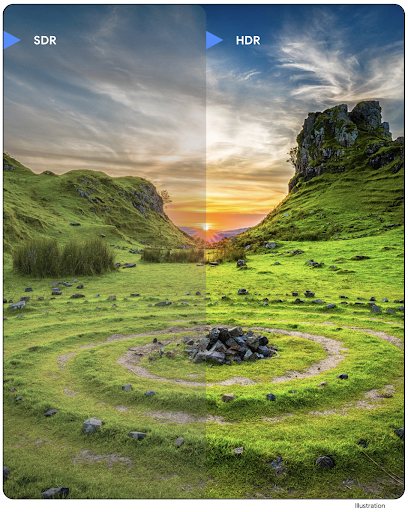
Android 14 agrega compatibilidad con imágenes de alto rango dinámico (HDR) que retienen más información del sensor cuando se toma una foto, lo que permite colores vivos y un mayor contraste. Android usa el formato Ultra HDR, que es totalmente retrocompatible con las imágenes JPEG, lo que permite que las apps interactúen sin problemas con las imágenes HDR y las muestren en rango dinámico estándar (SDR) según sea necesario.
El framework renderiza estas imágenes en la IU en HDR de forma automática cuando tu app habilita el uso de la IU HDR para su ventana de actividad, ya sea a través de una entrada de manifiesto o en el tiempo de ejecución mediante una llamada a Window.setColorMode(). También puedes capturar imágenes estáticas Ultra HDR comprimidas en dispositivos compatibles. Con más colores recuperados del sensor, la edición posterior puede ser más flexible. El Gainmap asociado con las imágenes Ultra HDR se puede usar para renderizarlas con OpenGL o Vulkan.
Zoom, enfoque, Postview y más en las extensiones de cámara
Android 14 actualiza y mejora las extensiones de la cámara, lo que permite que las apps manejen tiempos de procesamiento más largos, lo que permite mejorar las imágenes con algoritmos intensivos en procesamiento, como la fotografía con poca luz en dispositivos compatibles. Estas funciones les brindan a los usuarios una experiencia aún más sólida cuando usan las funciones de extensión de la cámara. Entre los ejemplos de estas mejoras, se incluyen los siguientes:
- La estimación de latencia de procesamiento de capturas estáticas dinámicas proporciona estimaciones de latencia de capturas estáticas mucho más precisas en función de las condiciones actuales de la escena y el entorno. Llama a
CameraExtensionSession.getRealtimeStillCaptureLatency()para obtener un objetoStillCaptureLatencyque tenga dos métodos de estimación de latencia. El métodogetCaptureLatency()muestra la latencia estimada entreonCaptureStartedyonCaptureProcessStarted(), y el métodogetProcessingLatency()muestra la latencia estimada entreonCaptureProcessStarted()y el fotograma procesado final que está disponible. - Compatibilidad con devoluciones de llamada de progreso de captura para que las apps puedan mostrar el progreso actual de las operaciones de procesamiento de capturas estáticas de larga duración. Puedes verificar si esta función está disponible con
CameraExtensionCharacteristics.isCaptureProcessProgressAvailabley, si es así, implementar la devolución de llamadaonCaptureProcessProgressed(), que tiene el progreso (de 0 a 100) pasado como parámetro. Metadatos específicos de la extensión, como
CaptureRequest.EXTENSION_STRENGTHpara marcar la cantidad de un efecto de extensión, como la cantidad de desenfoque de fondo conEXTENSION_BOKEHFunción de vista posterior para la captura de imágenes fijas en extensiones de cámara, que proporciona una imagen menos procesada más rápido que la imagen final. Si una extensión tiene una latencia de procesamiento mayor, se puede proporcionar una imagen posterior a la vista como marcador de posición para mejorar la UX y cambiarla más adelante por la imagen final. Puedes verificar si esta función está disponible con
CameraExtensionCharacteristics.isPostviewAvailable. Luego, puedes pasar unOutputConfigurationaExtensionSessionConfiguration.setPostviewOutputConfiguration.Compatibilidad con
SurfaceView, que permite una ruta de renderización de vista previa más optimizada y eficiente en términos de energía.Se agregó compatibilidad con el enfoque y el zoom con un toque durante el uso de la extensión.
Zoom en el sensor
When REQUEST_AVAILABLE_CAPABILITIES_STREAM_USE_CASE in
CameraCharacteristics contains
SCALER_AVAILABLE_STREAM_USE_CASES_CROPPED_RAW, your app
can use advanced sensor capabilities to give a cropped RAW stream the same
pixels as the full field of view by using a CaptureRequest
with a RAW target that has stream use case set to
CameraMetadata.SCALER_AVAILABLE_STREAM_USE_CASES_CROPPED_RAW.
By implementing the request override controls, the updated camera gives users
zoom control even before other camera controls are ready.
Audio USB sin pérdida
Android 14 gains support for lossless audio formats for audiophile-level
experiences over USB wired headsets. You can query a USB device for its
preferred mixer attributes, register a listener for changes in preferred mixer
attributes, and configure mixer attributes using the
AudioMixerAttributes class. This class represents the
format, such as channel mask, sample rate, and behavior of the audio mixer. The
class allows for audio to be sent directly, without mixing,
volume adjustment, or processing effects.
Productividad y herramientas para desarrolladores
Credential Manager
Android 14 adds Credential Manager as a platform API, with additional support back to Android 4.4 (API level 19) devices through a Jetpack Library using Google Play services. Credential Manager aims to make sign-in easier for users with APIs that retrieve and store credentials with user-configured credential providers. Credential Manager supports multiple sign-in methods, including username and password, passkeys, and federated sign-in solutions (such as Sign-in with Google) in a single API.
Passkeys provide many advantages. For example, passkeys are built on industry standards, can work across different operating systems and browser ecosystems, and can be used with both websites and apps.
For more information, see the Credential Manager and passkeys documentation and the blogpost about Credential Manager and passkeys.
Health Connect
Health Connect is an on-device repository for user health and fitness data. It allows users to share data between their favorite apps, with a single place to control what data they want to share with these apps.
On devices running Android versions prior to Android 14, Health Connect is available to download as an app on the Google Play store. Starting with Android 14, Health Connect is part of the platform and receives updates through Google Play system updates without requiring a separate download. With this, Health Connect can be updated frequently, and your apps can rely on Health Connect being available on devices running Android 14 or higher. Users can access Health Connect from the Settings in their device, with privacy controls integrated into the system settings.
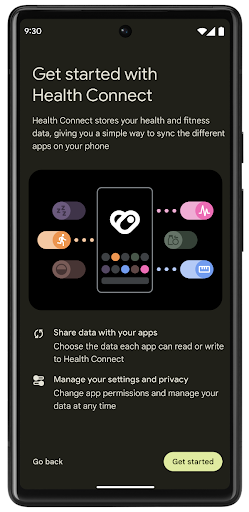

Health Connect includes several new features in Android 14, such as exercise routes, allowing users to share a route of their workout which can be visualized on a map. A route is defined as a list of locations saved within a window of time, and your app can insert routes into exercise sessions, tying them together. To ensure that users have complete control over this sensitive data, users must allow sharing individual routes with other apps.
For more information, see the Health Connection documentation and the blogpost on What's new in Android Health.
Actualizaciones de OpenJDK 17
Android 14 continues the work of refreshing Android's core libraries to align with the features in the latest OpenJDK LTS releases, including both library updates and Java 17 language support for app and platform developers.
The following features and improvements are included:
- Updated approximately 300
java.baseclasses to Java 17 support. - Text Blocks, which introduce multi-line string literals to the Java programming language.
- Pattern Matching for instanceof, which allows an object to
be treated as having a specific type in an
instanceofwithout any additional variables. - Sealed classes, which allow you restrict which classes and interfaces can extend or implement them.
Thanks to Google Play system updates (Project Mainline), over 600 million devices are enabled to receive the latest Android Runtime (ART) updates that include these changes. This is part of our commitment to give apps a more consistent, secure environment across devices, and to deliver new features and capabilities to users independent of platform releases.
Java and OpenJDK are trademarks or registered trademarks of Oracle and/or its affiliates.
Mejoras para tiendas de aplicaciones
Android 14 introduces several PackageInstaller APIs that
allow app stores to improve their user experience.
Request install approval before downloading
Installing or updating an app might require user approval.
For example, when an installer making use of the
REQUEST_INSTALL_PACKAGES permission attempts to install a
new app. In prior Android versions, app stores can only request user approval
after APKs are written to the install session and the
session is committed.
Starting with Android 14, the requestUserPreapproval()
method lets installers request user approval before committing the install
session. This improvement lets an app store defer downloading any APKs until
after the installation has been approved by the user. Furthermore, once a user
has approved installation, the app store can download and install the app in the
background without interrupting the user.
Claim responsibility for future updates
The setRequestUpdateOwnership() method allows an installer
to indicate to the system that it intends to be responsible for future updates
to an app it is installing. This capability enables update ownership
enforcement, meaning that only the update owner is permitted
to install automatic updates to the app. Update ownership enforcement helps to
ensure that users receive updates only from the expected app store.
Any other installer, including those making use of the
INSTALL_PACKAGES permission, must receive explicit user
approval in order to install an update. If a user decides to proceed with an
update from another source, update ownership is lost.
Update apps at less-disruptive times
App stores typically want to avoid updating an app that is actively in use because this leads to the app's running processes being killed, which potentially interrupts what the user was doing.
Starting with Android 14, the InstallConstraints API
gives installers a way to ensure that their app updates happen at an opportune
moment. For example, an app store can call the
commitSessionAfterInstallConstraintsAreMet() method to
make sure that an update is only committed when the user is no longer
interacting with the app in question.
Seamlessly install optional splits
With split APKs, features of an app can be delivered in separate APK files,
rather than as a monolithic APK. Split APKs allow app stores to optimize the
delivery of different app components. For example, app stores might optimize
based on the properties of the target device. The
PackageInstaller API has supported splits since its
introduction in API level 22.
In Android 14, the setDontKillApp() method allows an
installer to indicate that the app's running processes shouldn't be killed when
new splits are installed. App stores can use this feature to seamlessly install
new features of an app while the user is using the app.
Paquetes de metadatos de la app
Starting in Android 14, the Android package installer lets you specify app metadata, such as data safety practices, to include on app store pages such as Google Play.
Detecta cuando los usuarios toman capturas de pantalla del dispositivo
To create a more standardized experience for detecting screenshots, Android 14 introduces a privacy-preserving screenshot detection API. This API lets apps register callbacks on a per-activity basis. These callbacks are invoked, and the user is notified, when the user takes a screenshot while that activity is visible.
Experiencia del usuario
Acciones personalizadas y clasificación mejorada de Sharesheet
Android 14 actualiza la hoja compartida del sistema para admitir acciones personalizadas de la app y resultados informativos de la versión preliminar para los usuarios.
Agrega acciones personalizadas
Con Android 14, tu app puede agregar acciones personalizadas a la hoja compartida del sistema que invoca.
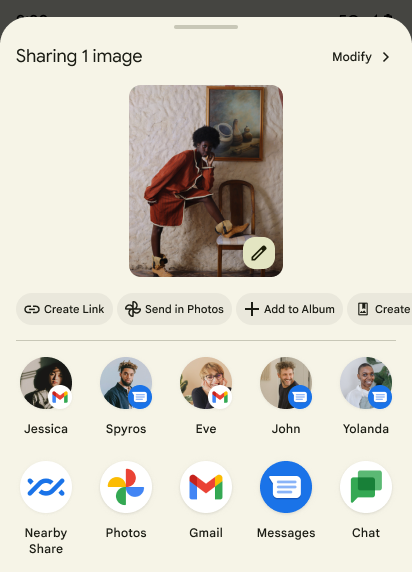
Mejora la clasificación de los objetivos de Direct Share
Android 14 usa más indicadores de las apps para determinar la clasificación de los objetivos de Direct Share para proporcionarles resultados más útiles al usuario. Para proporcionar el indicador más útil para la clasificación, sigue las instrucciones para mejorar las clasificaciones de tus objetivos de Direct Share. Las apps de comunicación también pueden informar el uso de combinaciones de teclas para los mensajes entrantes y salientes.
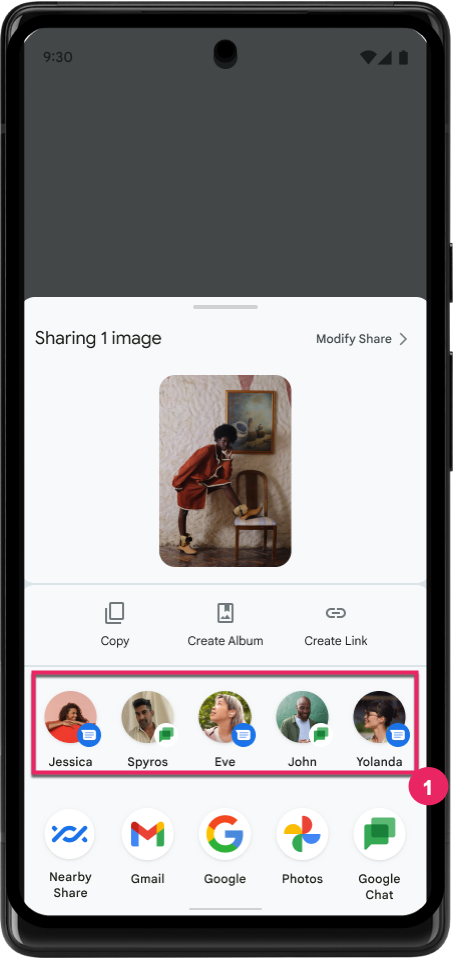
Compatibilidad con animaciones integradas y personalizadas para el gesto atrás predictivo
Android 13 introduced the predictive back-to-home animation behind a developer option. When used in a supported app with the developer option enabled, swiping back shows an animation indicating that the back gesture exits the app back to the home screen.
Android 14 includes multiple improvements and new guidance for Predictive Back:
- You can set
android:enableOnBackInvokedCallback=trueto opt in to predictive back system animations per-Activity instead of for the entire app. - We've added new system animations to accompany the back-to-home animation from Android 13. The new system animations are cross-activity and cross-task, which you get automatically after migrating to Predictive Back.
- We've added new Material Component animations for Bottom sheets, Side sheets, and Search.
- We've created design guidance for creating custom in-app animations and transitions.
- We've added new APIs to support custom in-app transition animations:
handleOnBackStarted,handleOnBackProgressed,handleOnBackCancelledinOnBackPressedCallbackonBackStarted,onBackProgressed,onBackCancelledinOnBackAnimationCallback- Use
overrideActivityTransitioninstead ofoverridePendingTransitionfor transitions that respond as the user swipes back.
With this Android 14 preview release, all features of Predictive Back remain behind a developer option. See the developer guide to migrate your app to predictive back, as well as the developer guide to creating custom in-app transitions.
Anulaciones por app del fabricante de dispositivos con pantalla grande
Per-app overrides enable device manufacturers to change the behavior of apps on large screen devices. For example, the FORCE_RESIZE_APP override instructs the system to resize the app to fit display dimensions (avoiding size compatibility mode) even if resizeableActivity="false" is set in the app manifest.
Overrides are intended to improve the user experience on large screens.
New manifest properties enable you to disable some device manufacturer overrides for your app.
Anulaciones por app para usuarios de pantallas grandes
Per-app overrides change the behavior of apps on large screen devices. For example, the OVERRIDE_MIN_ASPECT_RATIO_LARGE device manufacturer override sets the app aspect ratio to 16:9 regardless of the app's configuration.
Android 14 QPR1 enables users to apply per‑app overrides by means of a new settings menu on large screen devices.
Compartir pantalla de una app
App screen sharing enables users to share an app window instead of the entire device screen during screen content recording.
With app screen sharing, the status bar, navigation bar, notifications, and other system UI elements are excluded from the shared display. Only the content of the selected app is shared.
App screen sharing improves productivity and privacy by enabling users to run multiple apps but limit content sharing to a single app.
Respuesta inteligente potenciada por LLM en Gboard en el Pixel 8 Pro
En los dispositivos Pixel 8 Pro con la actualización de funciones de diciembre, los desarrolladores pueden probar respuestas inteligentes de mayor calidad en Gboard con la tecnología de modelos de lenguaje grandes (LLM) integrados en el dispositivo que se ejecutan en Google Tensor.
Esta función está disponible como versión preliminar limitada para inglés de EE.UU. en WhatsApp, Line y KakaoTalk. Requiere el uso de un dispositivo Pixel 8 Pro con Gboard como teclado.
Para probarlo, primero habilita la función en Configuración > Opciones para desarrolladores > Configuración de AICore > Habilitar Aicore persistente.
A continuación, abre una conversación en una app compatible para ver la respuesta inteligente potenciada por LLM en la barra de sugerencias de Gboard en respuesta a los mensajes entrantes.
Gráficos
Las rutas de acceso son consultables e interpolables
La API de Path de Android es un mecanismo potente y flexible para crear y renderizar gráficos vectoriales, con la capacidad de dibujar o rellenar una ruta, construir una ruta a partir de segmentos de línea o curvas cuadráticas o cúbicas, realizar operaciones booleanas para obtener formas aún más complejas o todas estas acciones de forma simultánea. Una limitación es la capacidad de descubrir lo que hay realmente en un objeto Path; los componentes internos del objeto son opacos para los llamadores después de su creación.
Para crear un Path, debes llamar a métodos como moveTo(), lineTo() y cubicTo() para agregar segmentos de ruta. Sin embargo, no hay forma de preguntarle a esa ruta cuáles son los segmentos, por lo que debes conservar esa información en el momento de la creación.
A partir de Android 14, puedes consultar rutas de acceso para descubrir su contenido.
Primero, debes obtener un objeto PathIterator con la API de Path.getPathIterator:
Kotlin
val path = Path().apply { moveTo(1.0f, 1.0f) lineTo(2.0f, 2.0f) close() } val pathIterator = path.pathIterator
Java
Path path = new Path(); path.moveTo(1.0F, 1.0F); path.lineTo(2.0F, 2.0F); path.close(); PathIterator pathIterator = path.getPathIterator();
A continuación, puedes llamar a PathIterator para iterar a través de los segmentos uno por uno y recuperar todos los datos necesarios de cada segmento. En este ejemplo, se usan objetos PathIterator.Segment, que agrupan los datos por ti:
Kotlin
for (segment in pathIterator) { println("segment: ${segment.verb}, ${segment.points}") }
Java
while (pathIterator.hasNext()) { PathIterator.Segment segment = pathIterator.next(); Log.i(LOG_TAG, "segment: " + segment.getVerb() + ", " + segment.getPoints()); }
PathIterator también tiene una versión de next() no asignable en la que puedes pasar un búfer para contener los datos de puntos.
Uno de los casos de uso importantes para consultar datos de Path es la interpolación. Por ejemplo, podrías animar (o transformar) entre dos rutas diferentes. Para simplificar aún más ese caso de uso, Android 14 también incluye el método interpolate() en Path. Si suponemos que las dos rutas de acceso tienen la misma estructura interna, el método interpolate() crea un Path nuevo con ese resultado interpolado. En este ejemplo, se muestra una ruta cuya forma está incompleta (una interpolación lineal de 0.5) entre path y otherPath:
Kotlin
val interpolatedResult = Path() if (path.isInterpolatable(otherPath)) { path.interpolate(otherPath, .5f, interpolatedResult) }
Java
Path interpolatedResult = new Path(); if (path.isInterpolatable(otherPath)) { path.interpolate(otherPath, 0.5F, interpolatedResult); }
La biblioteca graphics-path de Jetpack también habilita APIs similares para versiones anteriores de Android.
Mallas personalizadas con sombreadores de vértices y fragmentos
Android admite desde hace mucho tiempo el dibujo de mallas de triángulos con sombreado personalizado, pero el formato de malla de entrada se limitó a algunas combinaciones de atributos predefinidos. Android 14 agrega compatibilidad con mallas personalizadas, que se pueden definir como triángulos o tiras de triángulos, y, de manera opcional, se pueden indexar. Estas mallas se especifican con atributos personalizados, pasos de vértices, variaciones y sombreadores de vértices y fragmentos escritos en AGSL.
El sombreador de vértices define las variaciones, como la posición y el color, mientras que el sombreador de fragmentos puede definir de manera opcional el color del píxel, por lo general, con las variaciones creadas por el sombreador de vértices. Si el sombreador de fragmentos proporciona el color, se combina con el color Paint actual con el modo de combinación seleccionado cuando se dibuja la malla. Los uniformes se pueden pasar a los sombreadores de fragmentos y vértices para obtener mayor flexibilidad.
Procesador de búfer de hardware para Canvas
To assist in using Android's Canvas API to draw with
hardware acceleration into a HardwareBuffer, Android 14
introduces HardwareBufferRenderer. This API is
particularly useful when your use case involves communication with the system
compositor through SurfaceControl for low-latency
drawing.
